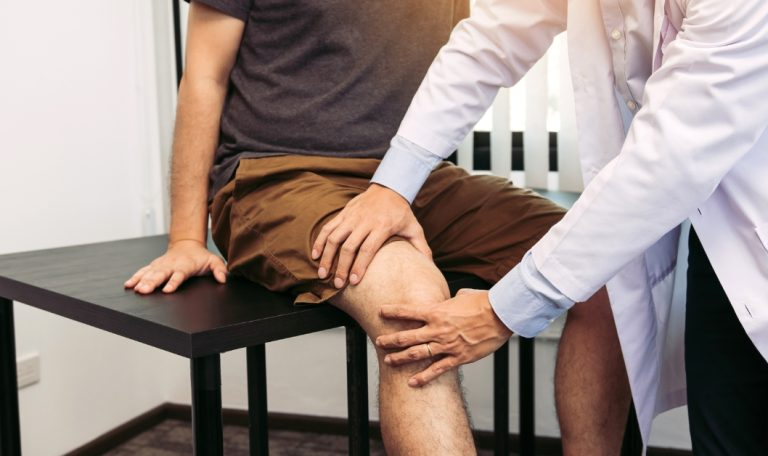Ever stood with your feet together and noticed a small space between your knees? This is what’s known as a knee gap. For some people, it’s simply part of how their body is built. For others, it may be linked to posture, muscle strength, or even an underlying medical condition.
While many knee gaps are harmless, others can affect walking comfort, athletic performance, or joint health. Understanding the difference is key to deciding if treatment is needed. Let’s take a closer look at what causes knee gaps, when to be concerned, and how they can be treated.
What Exactly Are Knee Gaps?
A knee gap is the space you see between your knees when you stand straight with your legs together. In some cases, this gap is just a normal result of your bone structure. In others, it might be related to leg alignment issues.
Knee gaps can appear:
- Naturally, simply because of the shape of your bones.
- Over time, due to muscle imbalances, injury, or lifestyle habits.
Having a knee gap is not automatically a cause for concern. However, if you also experience pain, discomfort, or changes in how you walk, it may be worth consulting a professional – such as a physiotherapist or the best orthopedic doctor in Ahmedabad if you’re in that region.

Causes of Knee Gaps – More Than Just Genetics
There are several possible reasons why someone might have a knee gap:
1. Natural Bone Structure
Some people naturally have a wider hip-to-knee angle. This is simply how their skeleton is shaped and is usually harmless.
2. Knock Knees or Bow Legs
Misalignment conditions such as knock knees (where knees angle inward) or bow legs (where knees curve outward) can make gaps more noticeable. These conditions are common in childhood but can persist into adulthood.
3. Weak Inner Thigh Muscles
If your inner thigh muscles are weak compared to your outer thigh muscles, it can pull your knees slightly outward, creating or worsening a gap.
4. Injury or Surgery History
An old injury or surgical procedure can sometimes alter the natural alignment of your legs, leading to visible gaps.
5. Rapid Weight Loss
Losing weight very quickly can reduce muscle tone in the thighs, making gaps appear more obvious.
6. Childhood Growth Patterns
The way your bones developed as a child can affect your leg alignment as an adult.
Myths vs Facts – Clearing Up Confusion
Here’s a quick comparison of common beliefs about knee gaps:
| Myth | Fact |
| Knee gaps are always a medical problem. | Many are purely cosmetic and harmless. |
| Only exercise can close a knee gap. | Exercise can help, but some cases require medical intervention. |
| Knee gaps mean you’re unhealthy. | Often just a variation in anatomy. |
| Surgery is the only solution. | Physiotherapy, targeted exercise, and orthotics can help too. |
How to Know If It’s a Problem
Not every knee gap needs attention. But you may want to speak to a specialist if you notice:
- Pain or discomfort in your knees, hips, or lower back.
- Trouble running, squatting, or climbing stairs.
- A gap that’s getting bigger over time.
- Uneven wear on shoes due to altered walking patterns.
An orthopaedic assessment can help determine if your knee gap is purely cosmetic or a sign of an underlying issue. In cities like Ahmedabad, you’ll find dedicated facilities such as a knee hospital in Ahmedabad where doctors use scans and posture analysis to understand the root cause.
Treatment Options – From Simple to Surgical
The right treatment depends entirely on the reason for your knee gap. Here are the most common approaches:
1. Targeted Exercises
Strengthening your inner thighs and improving overall leg muscle balance can help. Exercises may include:
- Squats
- Lunges
- Side-lying leg lifts
- Resistance band training
- Inner thigh squeezes
2. Physiotherapy
A physiotherapist can design a personalised exercise plan and correct walking posture. They may also use manual therapy techniques to help realign the knees.
3. Orthotics & Braces
If alignment is a problem, wearing supportive insoles or knee braces can help improve stability and prevent further misalignment.
4. Weight & Posture Management
Maintaining a healthy weight reduces strain on the knees. Good posture when standing, walking, and sitting also keeps leg alignment in check.
5. Medical Interventions
In severe cases, surgery might be recommended – for example, a corrective osteotomy to realign bones or ligament repair after injury. This is usually a last resort after other methods haven’t worked.

Preventing Knee Gap Progression
You can reduce the risk of knee gaps worsening by:
- Doing regular strength training for your legs.
- Avoiding prolonged standing with poor posture.
- Wearing well-fitted footwear.
- Getting early assessments for children who show unusual leg alignment.
Emotional & Confidence Aspects
For some people, the biggest concern about knee gaps is appearance rather than discomfort. Body image worries can affect confidence, especially in teenagers and young adults.
It’s important to remember that knee gaps are often just a natural part of your anatomy. If they cause no pain or movement issues, they may not require treatment. Where appearance is a concern, a mix of targeted exercise and physiotherapy can help improve muscle tone and leg shape.
Conclusion – Bringing It All Together
Knee gaps are often harmless and simply part of an individual’s natural body structure, but in some cases, they may indicate muscle imbalance, joint issues, or leg misalignment. While they may not always require treatment, persistent pain, discomfort, or changes in mobility should never be ignored. Addressing the cause early can prevent further complications and improve overall function.
From personalised exercise plans to advanced medical treatments, effective solutions are available to enhance both movement and appearance. For expert evaluation and tailored care, consulting a highly experienced specialist like Dr Meet Mehta ensures you receive the right diagnosis and treatment approach.





